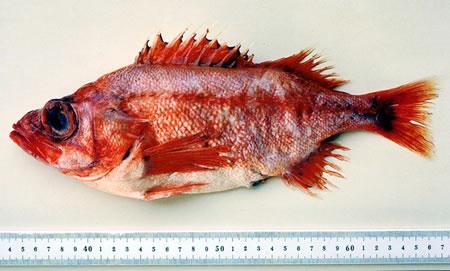Occasionally caught off the Washington coast by commercial harvesters using otter-trawls and longline gear.
Description and Range
Physical description
Splitnose rockfish are a deep-bodied, relatively small species with many sharp head spines and large eyes. The upper jaw is split with a toothed knob on either side. Underwater, adults are pale pink, light orange or white with darker pink, orange or red patches or bars on the dorsal surface, head and fins. After capture dorsal and side colors change to a uniform red or dark pink, while the belly remains pale. The dorsal fin spines may have white tips and the membranes between each spine may be dark fringed. Adult splitnose resemble the aurora and chameleon rockfishes but splitnose have a distinct, deep notch between the upper jaws (i.e., on their nose) and large eyes.
Splitnose rockfish can grow up to 46 cm (18.4 in) in length, and 180 g (0.4 lbs) in weight. Maximum age is at least 86 years old.
Geographic range
Splitnose rockfish range from the Alaska Peninsula and Prince William Sound, Alaska, to Cedros Island, Baja California. Adults are found at water depths from 91 to 795 m (299-2,622 ft). They are most common at depths from 215 to 350 m (705-1,155 ft). Pelagic juveniles up to 1 year old have been found among drifting vegetation in Puget Sound. Adults are benthic and commonly occur on low-relief mud fields of the continental shelf and upper slope. They have been found in the Hood Canal on mud and gravely deep sea mounds. While solitary animals are often seen resting on the seafloor, this species also forms schools off the bottom.
Regulations
Rules and seasons
Recreational harvest within Puget Sound has been closed.
